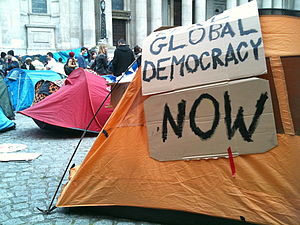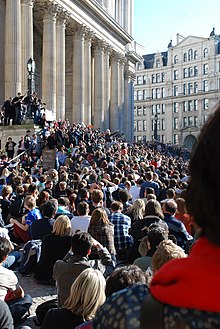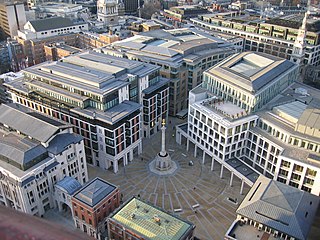
Paternoster Square is a former historic square, renamed from Newgate Market c. 1872, and now a post-war urban redevelopment, owned by the Mitsubishi Estate, next to St Paul's Cathedral in the City of London. The area was previously named Paternoster Row, after the street of the same name, once centre of the London publishing trade and was devastated by aerial bombardment in The Blitz during World War II. It is now the location of the London Stock Exchange which relocated there from Threadneedle Street in 2004. It is also the location of investment banks such as Goldman Sachs, Merrill and Nomura Securities, and of fund manager Fidelity Investments. The square itself, i.e. the plaza, is privately owned public space. In 2004, Christopher Wren's 1669 Temple Bar Gate was re-erected here as an entrance way to the plaza.

The modern environmental direct action movement in the United Kingdom started in 1991 with the formation of the first UK "Earth First!" group for a protest at Dungeness nuclear power station. Within two years, there were fifty Earth First groups and activists linked with other parties in the road protest movement. There were large camps at Twyford Down and the M11 link road protest. By 1997, the Government had decided to reduce its road-building plans by two thirds.

In England and Wales, squatting – taking possession of land or an empty house the squatter does not own – is a criminal or civil offence, depending on circumstances. People squat for a variety of reasons which include needing a home, protest, poverty, and recreation. Many squats are residential; some are also opened as social centres. Land may be occupied by New Age travellers or treesitters.

Occupy Los Angeles was one of the many occupy movements in the United States, following the original Occupy Wall Street (OWS) protest. Participants of Occupy L.A. first met at Pershing Square on September 23, 2011. Activists came to consensus to occupy public space in solidarity with the growing movement. Occupiers first marched in Los Angeles on September 24, 2011. They next protested a fundraiser being held in Hollywood at the House of Blues for President Obama. Participants met at Pershing Square every subsequent night to plan out the logistics of an occupation set to begin on October 1, 2011. After debating potential locations around Los Angeles, people decided on the lawns around City Hall. Tents first manifested on October 1, 2011 on the grounds of Los Angeles City Hall.

Occupy Boston was a collective of protesters that settled on September 30, 2011 in Boston, Massachusetts, on Dewey Square in the Financial District opposite the Federal Reserve Bank of Boston. It is related to the Occupy Wall Street movement that began in New York City on September 17, 2011.

The Occupy movement was an international populist socio-political movement that expressed opposition to social and economic inequality and to the perceived lack of real democracy around the world. It aimed primarily to advance social and economic justice and different forms of democracy. The movement has had many different scopes, since local groups often had different focuses, but its prime concerns included how large corporations and the global financial system control the world in a way that disproportionately benefits a minority, undermines democracy and causes instability.

Occupy Buffalo was a collaboration that included a peaceful protest and demonstrations which began on October 1, 2011, in Buffalo, New York, in Niagara Square, the nexus of downtown Buffalo opposite the Buffalo City Hall. It is related to the Occupy Wall Street movement that began in New York City on September 17, and called for economic equity, accountability among politicians and ending lobbyist influence of politicians. Protesters camped overnight in Niagara Square as part of the demonstration.
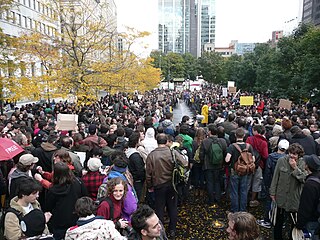
Occupy Canada was a collective of peaceful protests and demonstrations that were part of the larger Occupy Together movement which first manifested in the financial district of New York City with Occupy Wall Street, and subsequently spread to over 900 cities around the world.

The 15 October 2011 global protests were part of a series of protests inspired by the Arab Spring, the Icelandic protests, the Portuguese "Geração à Rasca", the Spanish "Indignants", the Greek protests, and the Occupy movement. The protests were launched under the slogan "United for #GlobalChange", to which the slogan "United for Global Democracy" was added by many people's assemblies. The protest was first called for by the Spanish Plataforma ¡Democracia Real YA! in May 2011 and endorsed by people's assemblies across the world. Reasons were varied but mainly targeted growing economic inequality, corporate influence over government and international institutions, and the lack of truly democratic institutions allowing direct public participation at all levels, local to global. Global demonstrations were held on 15 October in more than 950 cities in 82 countries. The date was chosen to coincide with the 5-month anniversary of the first protest in Spain. General assemblies, the social network n-1, mailing lists, Mumble voice chat, open pads such as Pirate Pad and Titan Pad, and Facebook were used to coordinate the events. Some protests were only a few hundred in number, whereas others numbered in the hundreds of thousands, with the largest in Madrid numbering half a million and the second largest city Barcelona with 400,000.

Occupy Toronto was a protest and demonstration that began on October 15, 2011, in Toronto, Ontario, near Bay Street in Downtown Toronto's Financial District and moved to St. James Park. It was a part of the Occupy movement, which protested against economic inequality, corporate greed, and the influence of corporations and lobbyists on government.
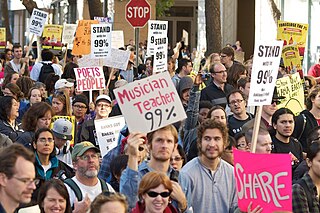
Occupy Oakland refers to a collaboration and series of demonstrations in Oakland, California, that started in October 2011. As part of the Occupy movement, protesters have staged occupations, most notably at Frank H. Ogawa Plaza in front of Oakland City Hall.
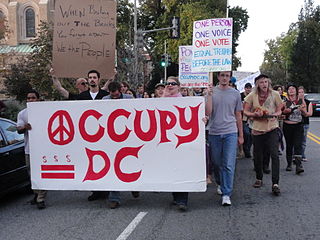
Occupy D.C. was an occupation of public space in Washington, D.C. based at McPherson Square and connected to the Occupy movements that sprung up across the United States in Fall 2011. The group had been demonstrating in McPherson Square since October 1, 2011, and in Freedom Plaza since October 6. Despite crackdowns on other Occupy projects across the country, federal authorities claimed on November 15 that they have no plans to clear McPherson Square Park. The National Park Service decided against eviction after meeting with activists and discussing health and safety conditions.

The Occupy movement spread to many other cities in the United States and worldwide beginning with the Occupy Wall Street protests in New York City in September 2011. The movement sought to advance social and economic justice and different forms of democracy but each local group varied in specific aims. The demonstrations and encampment in New York City spread to other major and smaller cities. Some camps lasted through 2012. What follows is an alphabetical, non-chronological summary of Occupy encampments in the United States.

Occupy Baltimore was a collaboration that included peaceful protests and demonstrations. Occupy Baltimore began on October 4, 2011, in Baltimore, Maryland, in McKeldin Square near the Inner Harbor area of Downtown Baltimore. It is one of the many Occupy movements around the United States and worldwide, inspired by Occupy Wall Street.
Occupy South Africa was a South African initiative primarily aimed at protesting and inciting mass action against the racial, economic and social inequality in South Africa. It is part of the globally Occupy Wall Street movement. It consists of a loose informal affiliation of on the ground groups and individuals across South Africa as well as internet based groups. Groups such as Taking Back South Africa!, Occupy South Africa are involved in South Africa and online. The movement is also involved with the Marikana miners' strike.

Occupy Sydney was a social movement and protest as part of the global Occupy movements, in Sydney, Australia. The occupation began on 15 October 2011 outside the Reserve Bank of Australia in Martin Place. The Martin Place occupation was first evicted by NSW Police on 23 October 2011. This eviction and later police action was named Operation Goulding. Another eviction attempt occurred on 2 February 2012. The protest site was removed five times in early July 2013, only to re-establish itself each time within hours.

General assemblies (GA) were the primary decision making bodies of the global Occupy Movement which arose in 2011. Open to all who wished to take part, general assemblies allowed for an inclusive form of direct democracy. Such assemblies aimed to establish a consensus among all participants.

The Bank of Ideas was a squatted, self-managed social centre in a disused UBS office complex on Sun Street in the City of London, England. It remained in the building from November 2011 until January 2012. The building was owned by UBS, and the squatters were members of the Occupy London protest movement. The building was described by an Occupy London spokesman as "a space for political discussion".
Occupy Bath was a protest group against economic inequality that began initially with an encampment on 30 October 2011 in Queen Square, Bath, England. The camp was dismantled on 10 December 2011. Occupy Bath described themselves as being "not all anti-capitalist" but rather "pro-economic fairness and pro-direct democracy". The camp held daily meetings, described by the group as general assemblies, which were open to the general public

Occupy Minneapolis (OccupyMN) is a grassroots collaboration that began in October 2011 with a series of demonstrations in Minneapolis, Minnesota. Protesters have staged numerous occupations, most notably of the Hennepin County Government Center plaza.
